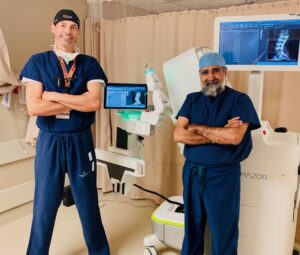Back and Spine Health
Spinal Fusion Recovery Time for Las Vegas Residents
We’ll preface this by saying that everyone’s journey to recovery is unique. No matter how eager or anxious you are to get back to ‘business as usual’, always listen to your body and follow the after-care instructions of your doctor and/or spine surgeons in the Las Vegas, NV area.
What is Spinal Fusion?
Spinal fusion refers to a surgical procedure during which one or more of your vertebrae are fused together. During the healing process, these vertebrae ‘fuse’ or heal together, forming a single solid bone.
By fusing the vertebrae together, we can effectively eliminate any friction between the bones, reducing pain, discomfort and pressure on the surrounding tissues, while reducing stretching of ligaments, musculature and nerves.
Spinal Fusion Success Rates
Although the procedure has a high degree of success for most patients, many postpone the surgery due to fear of a lengthy recovery. In this guide, we explore lumbar fusion recovery tips to help you get back on your feet faster.
Many patients who recover from spinal fusion are able to resume most, if not all, pre-surgery activities, including recreational sports.
Recovering After Spinal Fusion in Las Vegas
The recovery period following a spinal fusion procedure is important for patients to improve the odds of a successful outcome, as well as to quickly regain their mobility and strength.
In the vast majority of cases, patients are able to get discharged from the hospital within 2-4 days post-surgery. Once released, some patients may be required to wear a specialized brace to provide additional support.
Within 4-6 weeks, most patients are able to return to sedentary jobs, such as office work. Those eager to get back to a more physical lifestyle or job will need to wait between 3-6 months or as directed by their surgeon, with some activities prohibited up to one and a half years after the operation.
This recovery period gives the body the time it needs to heal and for the now-fused bones to fully solidify.
When we talk about spinal fusion or lumbar fusion recovery, we typically focus on three key areas to aid patients with a comfortable, safe and progressive recovery that gets them back to life as usual as quickly as possible.
The Three Key Areas of Recovery Include:
- Pain management
- Prevention of complications and setbacks; and
- Rehabilitation
Pain Management
Pain is a natural part of healing, and although it can be uncomfortable, a certain degree of discomfort is normal and to be expected. That said, excessive pain or worsening pain not only could be an indication of something more serious, it can also put undue stress on an already taxed body.
Because of this, we work with patients to help assess their natural pain tolerance and find the ideal solution to help them remain comfortable throughout the entire recovery process. For some this includes the use of heating and cooling pads, gentle massage, stretching and therapeutic movements. For others, it may include pain management medications such as non-steroidal anti-inflammatory drugs, local anesthetics or opioids.
Prevention of Complications
The most important thing here is to follow the post-operation care instructions provided by your healthcare team. Doing so can make sure you’re taking a proactive role in your recovery and minimize the risks of any complications.
That said, there are some signs of trouble you should watch out for. The two most common types of complications during spinal fusion recovery are infection and blood clots. While both are moderately rare, early intervention in the case of either can be lifesaving.
Warning Signs of an Infection Include:
- Localized redness, swelling or tenderness around the surgical wound
- A fever or chills
- Excessive or odorous draining from the wound
Warning Signs of a Blood Clot Include:
- Pain in the calf or leg
- Tenderness or redness of the knee
- Swelling in the foot, ankle or calf
*Although the surgery itself is physically far away from your lower extremities, it is in the lower extremities, such as your legs, where blood clots are most likely to form due to inactivity when recovering.
Rehabilitation
Immediately following your surgery, a good portion of your rehabilitation will focus on keeping wounds clean and dressed, managing pain and re-learning how to move without putting undue strain on your spine (mostly avoiding twisting motions).
Posture: Throughout the healing process your spine must maintain proper alignment. Your healthcare team will teach you how to stand, sit, walk and reposition without causing strain on your newly fused bones.
Gentle Activity: For some patients, light activity can aid with improving blood flow, maintaining mobility, reducing muscular tension, and encouraging the healing process. Your physical therapist and/or spine specialist may prescribe light stretching exercises after your first month of healing. Leading up to that point, your doctor may suggest walking at a slow and deliberate pace.
Physical Therapy: Typically begins between 6 weeks to 3-months post-surgery. Physical Therapy can provide you with the tools to progressively regain mobility, strength, balance and more while listening to your body and encouraging healthy recovery.
Lifestyle: A leading a healthy lifestyle after your surgery is imperative for giving your body what it needs to self-repair. A healthy diet rich in nutrients, calcium, and lean proteins, adequate sleep, and reduced stress can all accelerate spinal fusion recovery. Similarly, there are things you want to avoid, such as drinking alcohol in excess, and nicotine products, including but not limited to smoking.

Have More Questions? Ready to Learn More About Spinal Fusion Recovery?
Reach out to the Robotic Spine Institute of Las Vegas today and find out how their spine surgeons in Las Vegas, NV can help you take back control of your spine health, mobility and quality of life.